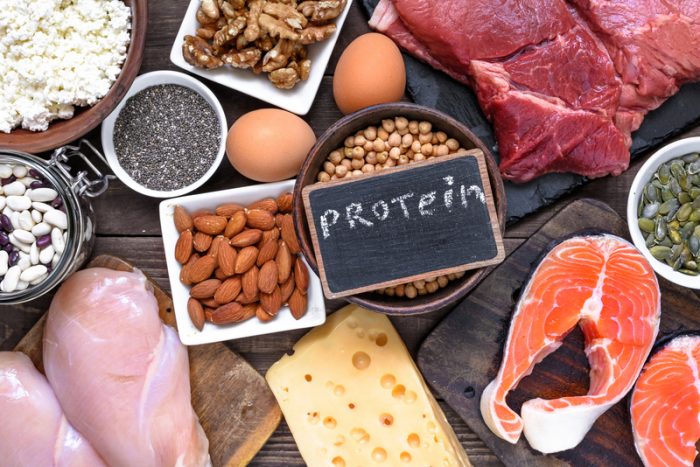

· By Anabela Ferreira
Are all proteins the same? Types, sources, and nutritional value
Key Points:
- Protein is an essential macronutrient, and recommendations vary depending on factors such as age, lifecycle stage, physical activity level, and specific goals. Athletes and those with a higher physical activity level may require additional protein. Higher protein consumption can also help preserve lean body mass during weight loss.
- Protein can be obtained from various food sources; however, isolated protein powders can be a convenient way to assure an optimum protein intake.
- Whey protein, derived from milk, is a popular isolated protein used to support muscle hypertrophy and improve body composition, mainly due its high nutritional value (high content of essential amino acids, and branched-chain amino acids, such as leucine).
Protein is an essential macronutrient required for the growth, repair, and maintenance of body tissues, such as muscle, skin, and blood. Besides being necessary for enzymatic activity, immunity, cell signalling, and muscle contraction, dietary proteins also provide an important source of nitrogen and energy (providing 4 kcal per gram). [1]
However, when it comes to protein, not all sources and types are created equal. In this article, we will explore the different types of proteins, their sources, and the nutritional value they offer, with a specific focus on isolated proteins like whey protein.
Understanding Protein
Proteins are composed of amino acids, which are organic compounds that serve as the building blocks for protein synthesis. There are 20 different amino acids, and the sequence and arrangement of these amino acids determine the structure and function of each protein (proteins are constantly being built and degraded in a dynamic process known as protein turnover). Of these amino acids, 9 are classified as indispensable (as they cannot be synthesised in the human body) and most of the remaining are categorized as dispensable amino acids (which can under normal physiological conditions be synthesised in the body). [2]
Protein Recommendations
The current recommended protein intake for adults is 0.83 g/kg body weight per day. [2] These needs may vary depending on factors such as age, lifecycle stage (pregnancy, lactation, and aging), and physical activity level. Individuals undertaking vigorous physical activity or a strength-based training programmes (athletes, bodybuilders, marathon runners) may need additional protein.
Protein has also been studied the role of maintaining muscle mass during weight loss phases, and in aging, because of its implications in chronic disease prevention, functional capacity, and quality of life. [3] Studies suggest that higher protein consumption (>1.25 g/kg/d) during caloric restriction resulted in greater losses of body weight and fat mass and attenuated decreases in lean body mass. [4] Higher-protein diets also promote weight loss through increased satiety, resulting in lower food intake. [5]
Protein Sources
Foods of animal origin with a high protein content are meat, fish, eggs, milk, and dairy products. Pulses, soy, cereals (and grain-based products), but also nuts and seeds include some plant-based sources of protein. Most of the animal sources are considered high quality protein because they usually have an optimal indispensable amino acid composition, and a high digestibility, whereas the content of 1 or 2 indispensable amino acids of plant proteins and/or their digestibility is sometimes lower. However, the daily combination of varied plant-based foods ensures an adequate amino acid profile for human needs.
Milk Proteins
Whey protein is one of the most used supplements by athletes and sports nutrition product consumers to support muscle hypertrophy and improve body composition. But how is it obtained? Whey is an isolated protein, which means it has been separated or extracted from milk, during the cheese-making process, and undergoes various processing methods to obtain a concentrated form of protein.
Whey protein has gained significant popularity in recent years due to its high nutritional value, given its amino acid content (high indispensable, branched-chain amino acids, and leucine), high digestibility and rapid absorption by the body, making it an ideal choice for recovery and muscle protein synthesis. [3]
Whey protein is available in various forms, including whey protein concentrates, isolates, and hydrolysates. Whey protein concentrates contain varying levels of protein, along with small amounts of fat and lactose. Whey protein isolates undergo further processing to remove most of the fat and lactose, resulting in a higher protein content per serving. Whey protein can be easily incorporated into a balanced diet, through Yogoody Protein shakes.
Proteins play a crucial role in maintaining optimal health. While they can be found in many foods, sometimes isolated proteins, like whey protein, offer a convenient and concentrated source of high-quality protein. Whether you choose whey protein or other protein sources, it's important to consider your dietary needs, health and performance goals, and personal preferences, to meet your protein requirements for overall well-being.
References:
-
British Nutrition Foundation. Protein. 2021; Available from: https://www.nutrition.org.uk/healthy-sustainable-diets/protein/?level=Health%20professional.
-
EFSA Panel on Dietetic Products, N. and Allergies, Scientific Opinion on Dietary Reference Values for protein. EFSA Journal, 2012. 10(2): p. 2557.
-
Devries, M.C. and S.M. Phillips, Supplemental protein in support of muscle mass and health: advantage whey. J Food Sci, 2015. 80 Suppl 1: p. A8-A15.
-
Longland, T.M., et al., Higher compared with lower dietary protein during an energy deficit combined with intense exercise promotes greater lean mass gain and fat mass loss: a randomized trial. Am J Clin Nutr, 2016. 103(3): p. 738-46.
-
Skov, A.R., et al., Randomized trial on protein vs carbohydrate in ad libitum fat reduced diet for the treatment of obesity. Int J Obes Relat Metab Disord, 1999. 23(5): p. 528-36.



